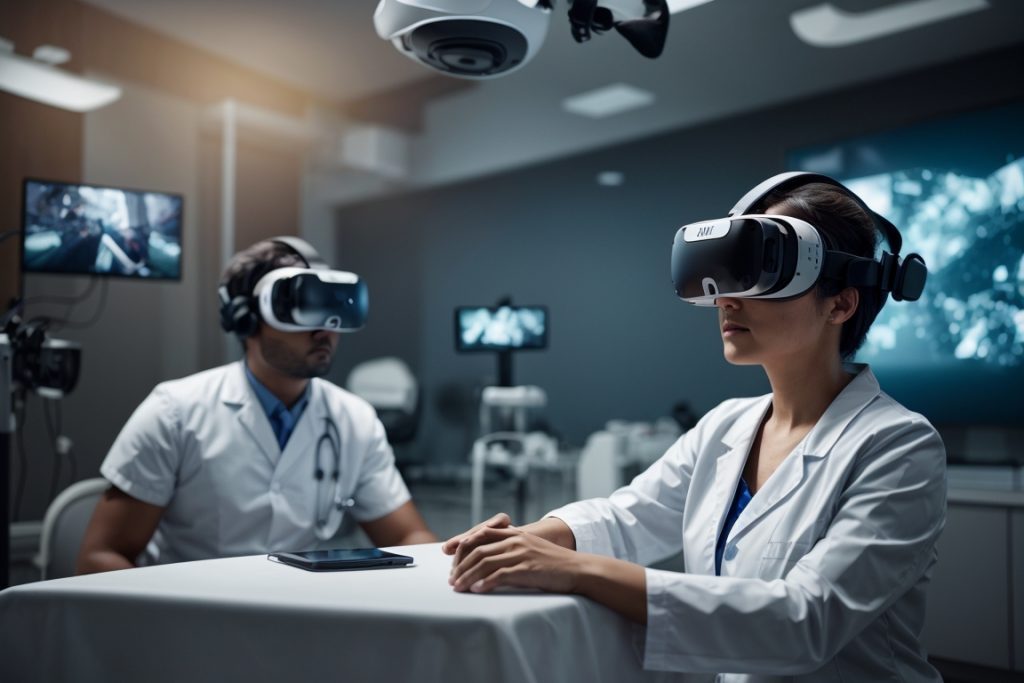
Virtual Reality in Healthcare
Virtual reality (VR) has emerged as a transformative technology with the potential to revolutionize various industries, including healthcare. VR offers a unique immersive experience that can be used to provide patients with new and innovative treatment options. In this blog post, we will explore the current applications of VR in healthcare and discuss its future potential.
Current Applications of VR in Healthcare
VR is already being used in a variety of healthcare applications, including:
- Pain Management: VR can be used to distract patients from pain by immersing them in virtual environments that are relaxing or engaging. This can be particularly beneficial for patients with chronic pain or pain that is difficult to treat with medication.
- Cognitive Rehabilitation: VR can be used to improve cognitive function in patients with conditions such as stroke, Alzheimer’s disease, and autism. VR-based exercises can help to improve memory, attention, and problem-solving skills.
- Surgical Training: VR is being used to train surgeons on complex procedures. VR simulations can provide a safe and realistic environment for surgeons to practice their skills before performing real-world operations.
- Patient Education: VR can be used to educate patients about their conditions and treatments. VR simulations can provide a more engaging and interactive way for patients to learn about their health.
- Telemedicine: VR can be used to provide telemedicine services, allowing patients to consult with doctors from remote locations. VR can also be used to provide virtual reality therapy for patients with mental health conditions.
Future Potential of VR in Healthcare
The future potential of VR in healthcare is vast and exciting. As VR technology continues to develop, we can expect to see even more innovative applications emerge. Some potential future applications of VR in healthcare include:
- Virtual Reality Therapy: VR can be used to provide therapy for patients with a variety of mental health conditions, such as anxiety, depression, and post-traumatic stress disorder. VR simulations can provide a safe and controlled environment for patients to confront their fears and develop coping mechanisms.
- Virtual Reality Surgery: VR can be used to guide surgeons during complex procedures, providing them with real-time information about the patient’s anatomy and assisting them in making decisions.
- Virtual Reality Rehabilitation: VR can be used to provide more intensive and personalized rehabilitation for patients with physical injuries or disabilities. VR-based exercises can help patients regain strength, coordination, and mobility.
- Virtual Reality Surgery Planning: VR can be used to develop personalized surgical plans for patients, taking into account their individual anatomy and needs. This can help to improve surgical outcomes and reduce complications.
- Virtual Reality Pain Management for Chronic Pain: VR can be used to provide long-term pain management for patients with chronic pain, such as back pain or arthritis. VR simulations can help to distract patients from their pain and improve their quality of life.
Challenges and Opportunities
Despite the potential benefits of VR in healthcare, there are also some challenges that need to be addressed. These challenges include:
- Cost of VR Technology: VR equipment can be expensive, which may limit its accessibility to some patients.
- Acceptance of VR by Patients and Providers: There may be some resistance to the use of VR in healthcare, as some patients and providers may not be familiar with the technology or may be concerned about its safety and efficacy.
- Development of Standardized VR Applications: There is currently a lack of standardized VR applications for healthcare, which makes it difficult for providers to adopt and implement VR into their practices.
- Regulatory Approval: VR devices and applications may need to be approved by regulatory agencies before they can be used in clinical settings.
VR has the potential to revolutionize healthcare by providing patients with new and innovative treatment options. As VR technology continues to develop and challenges are addressed, we can expect to see even more widespread adoption of VR in healthcare.